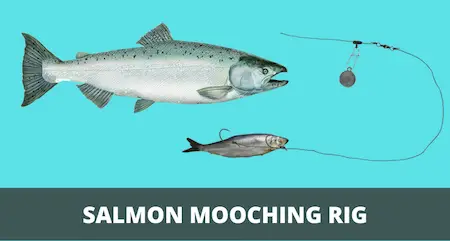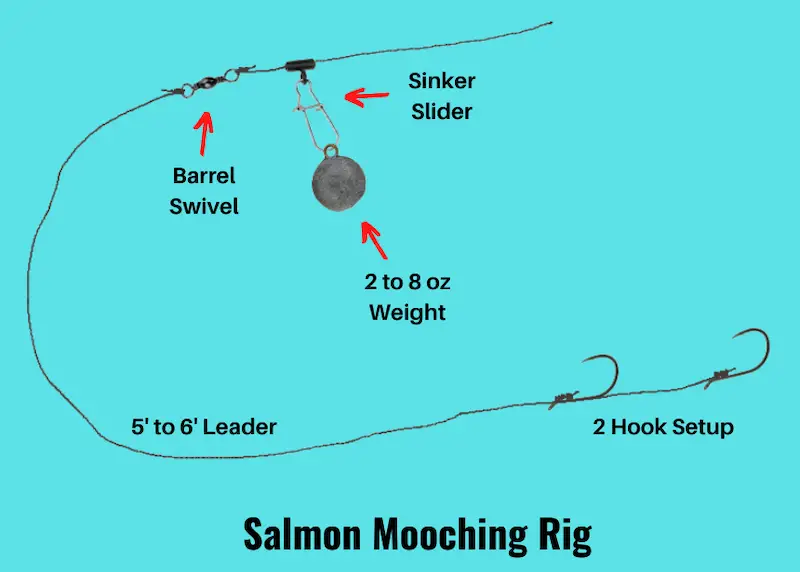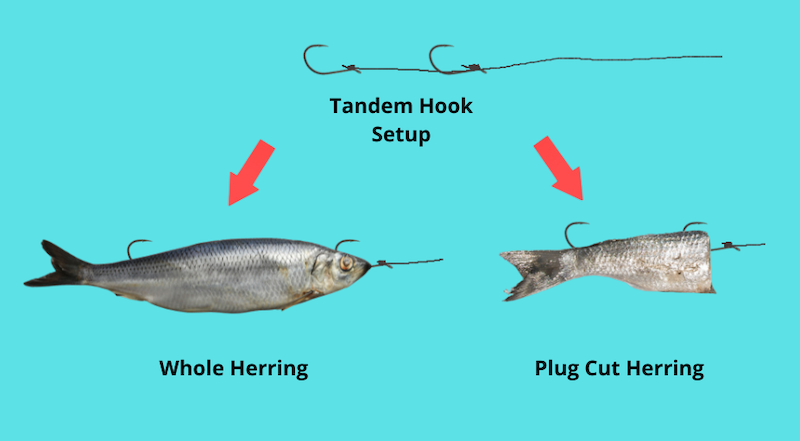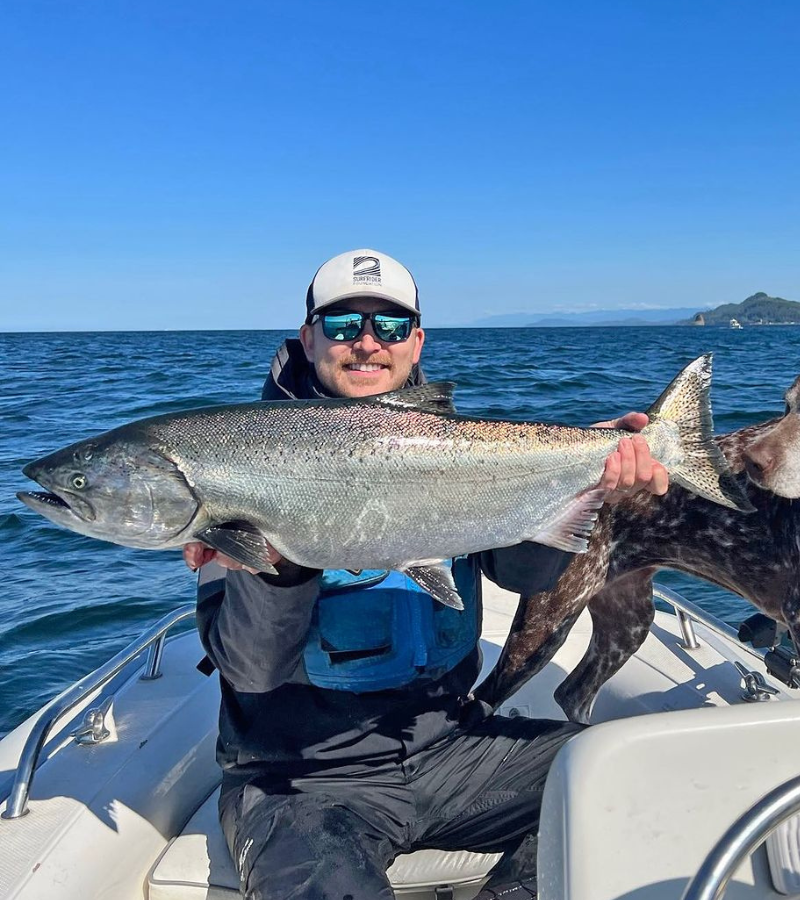Salmon Mooching Rig 101 (Setup & Fishing Guide w Pictures)
PUBLISHED 10 SEPTEMBER 2023
by Robert Ceran
Are you planning to use a mooching rig for salmon, but aren’t sure how to set it up, or how to fish it for the best results?
While the mooching rig is undoubtedly one of the most effective setups for saltwater salmon fishing, it can be tricky to set up, and to fish correctly.
In this article I’ll explain how to set up a salmon mooching rig, and will aso cover what bait to use with it, and how to fish it for optimal results.

What is a salmon mooching rig (and what is it good for)?
A mooching rig is a salmon bait setup consisting of a heavy sinker that rides on the main line with a sinker slide, as well as a barrel swivel connecting the mainline to a 5 foot leader with two hooks tied to the end of it.
The mooching rig is ideal for saltwater drift fishing for Pacific salmon, and it is usually baited with anchovies, herring, or sardines. This setup requires using a line counter reel to control the depth at which you fish.
While some anglers claim that trolling for salmon catches more fish than salmon mooching, I’ve found that both fishing tactics are equally effective for catching salmon in saltwater.
I also think that mooching for salmon is more fun than trolling, since you hold the rod in your hands at all times, which means you feel the bite of the salmon, and then get to set the hook before fighting the fish.
Mooching rig components
In order to tie a mooching rig, you’ll need the following tackle components:
- Braided main line (60 to 70 lb test)
- Fluorocarbon or monofilament leader (20 to 30 lb test)
- Mooching sinker (2 to 10 oz)
- Octopus hook (2/0 to 5/0)
- Sinker slider
- Barrel swivel
Choose the size of the sinker to match the depth and the strength of the current where you’re planning to fish. The nice thing about using a sinker slide is that it comes with a snap that allows you to swap the sinker quickly and easily.
The size of the hook depends on the size of the bait, as well as the size of the salmon. In general, the top hook is used to attach the baitfish, while the bottom hook is allowed to trail free in the water, and acts as a stinger hook. The top hook is generally smaller than the bottom hook.
How to tie a mooching rig

Now let’s dive into the details of the salmon mooching rig setup:
The first step is to thread the sinker slider onto your main line, and then tie the tag end to a barrel swivel. Next, attach the sinker to the snap of the sinker slide (as in the image above).
Then measure out about 5 to 6 feet of fluoro leader line, and tie a 2 hook snell knot at the end of it. Choose the distance between the two hooks so that the second hook trails close to the tail end of your baitfish when the first hook is inserted into the head.
If you use an adjustable 2 hook knot, this allows you to tie a mooching slip rig, which means you can adjust the distance between the hooks later on. However, I’ve found that this isn’t really necessary if you get the distance roughly correct in the first place.
Finally, tie the tag end of the leader to the barrel swivel, bait the double hook setup, and you’re ready to start fishing.
What bait should you use with a mooching rig?

The most commonly used baits for mooching rigs for king salmon are salted herrings, smelt, sardines, or anchovies, which you can buy at most tackle shops or bait shops. If you can get your hands on fresh baitfish, that’s even better, but not essential for success.
Finally, you can also use cut plug herring, which generates a characteristic spinning action in the water that sometimes triggers salmon bites more effectively than when you use a whole dead herring.
If you’re fishing with dead baitfish, you might also be interested in our guide to the meat rig for salmon.
How to fish a mooching rig for salmon
If you’re salmon fishing in the Pacific Northwest, the best way to fish this setup is by drift fishing from a boat near the coast.
Bait your salmon mooching rig with a salted herring, by poking the top hook of your mooching rig through the nose of the herring, and then re-inserting it into the head.
This way of hooking the herring results in the baitfish spinning in the water, which is ideal for triggering bites.
Next, cast out your mooching rig about 30 feet from the boat, or lower it slowly down into the water if the current is strong enough.

Image source: instagram/@seattlefishingcompany
If you drop it down too fast in a weak current, the bait and leader will tend to wrap around your mainline, resulting in an unholy tangle that can take a long time to fix.
This is why it’s better to cast your fishing rig out from the boat, as that results in a shallower angle of your main line during the drop, and then lower the mooching rig slowly down to the desired depth.
It’s essential to use a line counter reel if you want to mooch for salmon, as that enables you to control the exact depth range at which your fish for salmon.
After you reach the right depth with your salmon mooching setup, slowly start reeling it back up to the surface. This technique produces by far the most bites, as it allows you to search for salmon at a range of different depths as you slowly retrieve the mooching rig to the surface.
Some anglers prefer to troll their mooching setup similar to a salmon hoochie trolling rig, or to jig it up and down with their rod tip while drifting with the boat.
But personally, I’ve found that slowly retrieving your setup back to the surface and then lowering it all the way down again catches the most fish, since you cover a range of depths that way.
